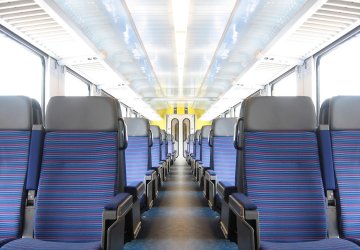
As a student I had a pretty good knack for sensing just where to stand on the platform to line up with the train doors. That meant no matter how busy it was I could always be the first to find a good seat. I recently traveled by train again for the first time in ages, but this time I wasn’t standing in the right place ... had I lost my touch?
Smart traveling
Fortunately the train wasn’t busy that morning and I was able to continue my trip from Nijmegen to Den Bosch in a good seat before changing for the Intercity to Amsterdam. However, I noticed something interesting during that commute—Dutch rail operator NS, or ProRail, was conducting an innovative pilot project.
Above the entire length of the platform in Den Bosch was a LED screen showing exactly where the doors of the train would end up, and which sections represented the right class (1st and 2nd).This may not seem significant at first glance, but there’s value in knowing immediately where best to stand. The screen displayed extra information as well, including indications for quiet carriages, restrooms, and accessibility for the disabled.
Of course, I can imagine a few more options to further improve things. For example, what if the screen could display the level of occupancy for each section? A colored scale could indicate the occupancy clearly: Green—Orange—Red. However, would the occupancy rate hold any use beyond the instant gratification of knowing which section of the train to board for the best chance of an empty seat?
Innovation in sensor technology and Big Data analytics may be the key to answering this question. Data collected from the occupancy rate of the train today, may help commuters better plan their future trips. For example, let’s say with occupancy rate data we know the percentage of people getting off the train at a specific time in Den Bosch during the train ride from Maastricht to Alkmaar. With this data we can predict what time and which station we have the best chance of getting a seat on that train.
Smart working
The great thing about a train journey is the time it gives you to have a great brainstorming session about these types of innovations. The parallels between smart traveling and smart working become easily recognizable. Just like wanting a good seat on the train, when you arrive at an office building, you would like to see at a glance where there will be a suitable workstation for you.
I challenge you on your next journey to give some thought to your office environment and the use of flexible space like meeting rooms and empty desks. Can you quickly find an unoccupied area or a meeting room which fulfills your needs? Can you quickly locate the colleague you’ll be working with that day? And what would it mean for your time and cost management if there was indeed better insight for this?
On the way back
On my return journey, I was doing a little more pondering about these display screens. What’s in it for the NS? Naturally this service contributes to customer satisfaction, but in the future could it also mean shorter stops at the platform? Perhaps more insight into the occupancy rate could also lead to more efficient use of equipment and personnel, even at a basic level. Because, we all know sticking to the railway timetable isn’t always the train’s greatest forte—maybe, just maybe this could help.





















